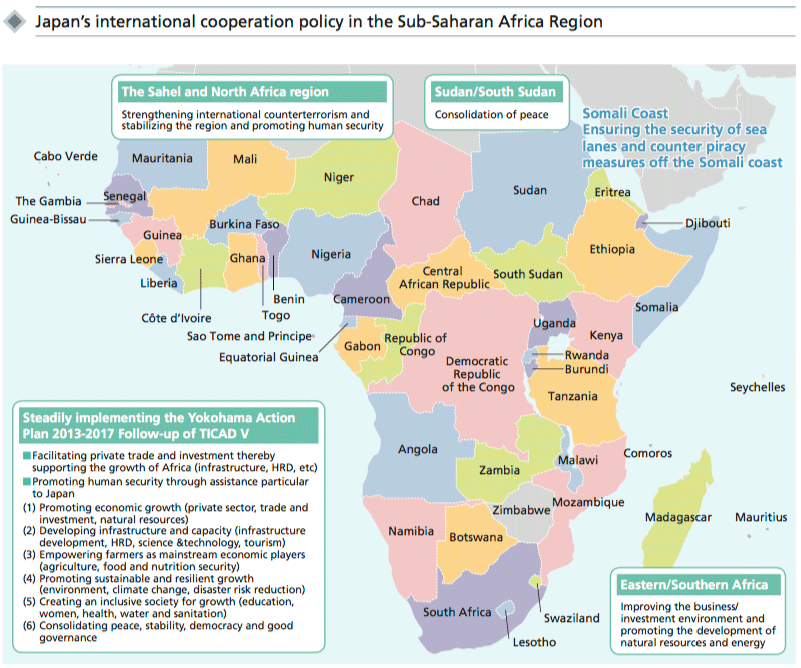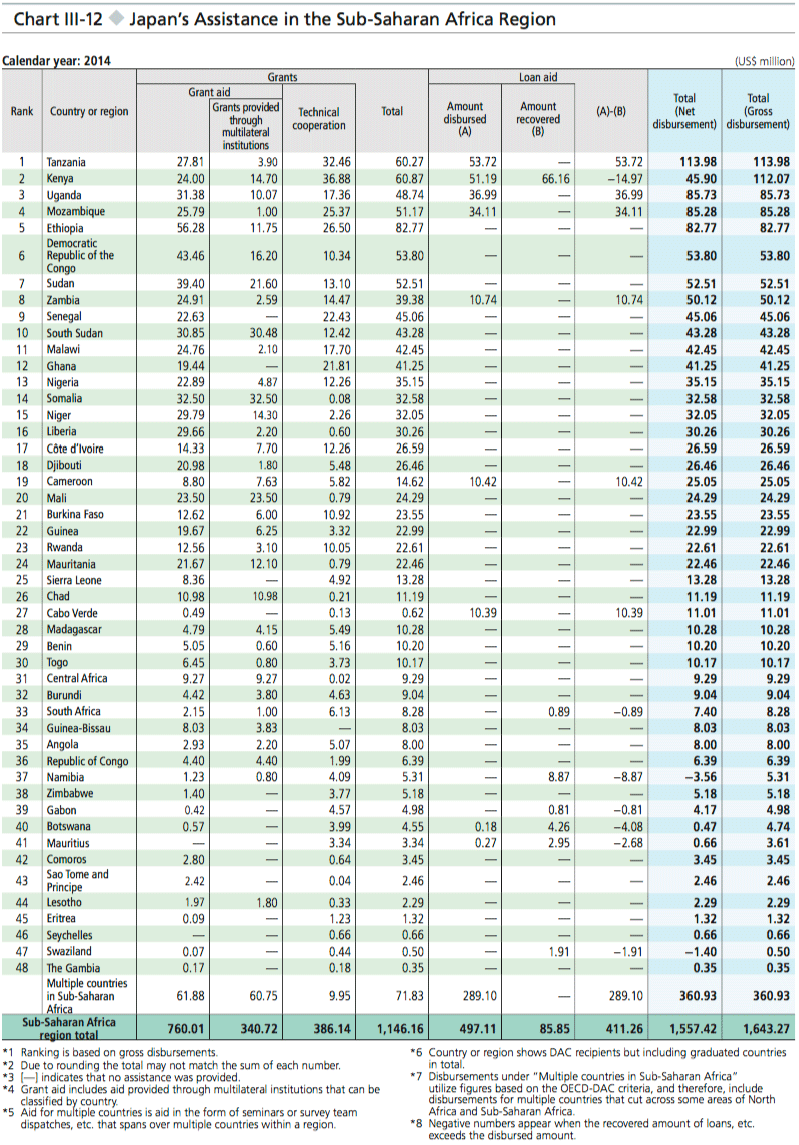5. Sub-Saharan Africa
In the past, many in the international community had a pessimistic outlook for the African economy. Since the 2000s, however, as the continent began to register remarkable growth underpinned by its rich natural resources and growing population, Africa has expanded its presence as a “future global growth center,” drawing expectations and attention from the international community. Nonetheless, the region of Sub-Saharan Africa in particular, which lies south of the Sahara desert, still faces chronic poverty, economic disparities, lagging infrastructure development, low agricultural productivity, and shortage of industrial human resources. Furthermore, the continent is confronting new challenges in recent years, including the slowdown of the markets for commodities such as natural resources, the Ebola virus disease (EVD) outbreak, and frequent terrorist attacks. In response to these issues, the African Union (AU) Summit in January 2015 adopted the Agenda 2063 for the socio-economic transformation of Africa. In addition, in September 2015, the UN adopted new development goals named the 2030 Agenda for Sustainable Development. In this way, both Africa and the international community have launched new efforts for the continent.
< Japan’s Efforts >
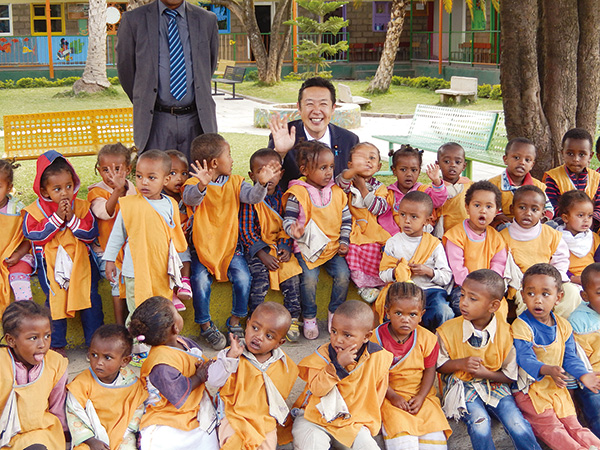
Parliamentary Vice-Minister for Foreign Affairs Hitoshi Kikawada visits the Selam Children Village in Ethiopia, supported by Japan, in December, 2015.
For over 20 years, Japan has spearheaded the Tokyo International Conference on African Development (TICAD) process, through which it has proactively supported Africa’s efforts to address development challenges, under the basic principle of ownership and partnership, whereby the international community extends support for Africa’s own efforts.
In June 2013, TICAD V was held in Yokohama under the theme of “Hand in Hand with a More Dynamic Africa.” Japan announced its commitment to supporting the growth of Africa through private and public means of up to approximately ¥3.2 trillion, including ODA of approximately ¥1.4 trillion, in the next five years based on the basic policy of: encouraging the trade and investment of the private sector; and promoting human security. Specifically, the assistance has the following pillars: (i) “Boosting economic growth (private sector development, trade and investment, natural resources)”; (ii) “Accelerating infrastructure and capacity development (infrastructure, human resources development, science and technology, tourism)”; (iii) “Empowering farmers as mainstream economic actors (agriculture, food and nutrition security)”; (iv) “Promoting sustainable and resilient growth (environment, climate change, disaster risk reduction)”; (v) “Creating an inclusive society for growth (education, gender, health, water and sanitation)”; and (vi) “Consolidating peace, stability, democracy and good governance.”
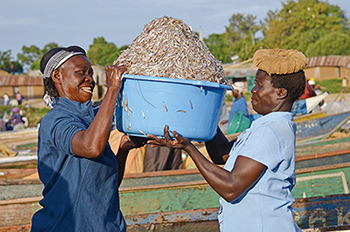
A resident of a fishing village in Siaya County in western Kenya helping a fellow worker put on his head a tub piled high with small fish called omena. (Photo: Takeshi Kuno)
At the TICAD V Ministerial Meeting held in Cameroon in May 2014, Japan reported on the steadfast implementation of Japan’s assistance pledged at TICAD V, and many African countries highly appreciated Japan’s assistance thus far. By September 2015, for example, approximately 470 young people from Africa have entered Master’s programs at Japanese universities, under the African Business Education Initiative for Youth (ABE Initiative),(Note 8) which is aimed at training industrial human resources. Japan has also begun establishing “strategic master plans” to assist quality infrastructure development in nine locations, including the Nacala Corridor centered around Mozambique, the Northern Corridor centered around Kenya, and West African countries such as Côte d’Ivoire and Ghana.
Aside from these efforts, Japan has also strengthened its relations with Africa through various initiatives including the holding of the Japan-African Regional Economic Communities (RECs) Summit Roundtable in New York in September 2013 and September 2014 on “agricultural development” and “infrastructure development,” respectively.
In this process, in August 2015, it was decided at the request of the African side that the TICAD summit meeting would be held for the first time in Africa in 2016 in Kenya. Japan welcomes this as a manifestation of African ownership.
Japan will continue to steadily carry out assistance that is wide-ranging and unique to Japan in areas such as economic growth involving private investment, development, and peace and stability, while taking into consideration the development issues facing Africa and the international community. Japan will contribute to achieving “quality growth” in Africa through public-private partnerships, in parallel with building mutually beneficial relations with African countries.
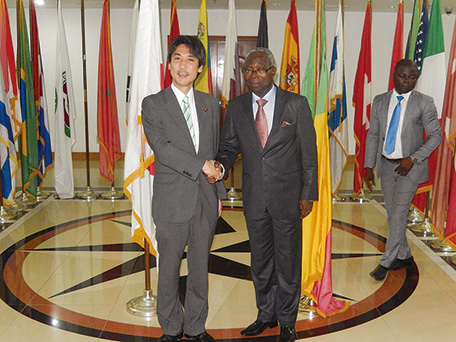
Then State Minister for Foreign Affairs Minoru Kiuchi meets with Minister for Foreign Affairs, African Integration, Francophonie and Beninese in Diaspora Saliou Akadiri in August 2015.
- Note 8: At TICAD V, Japan announced its intention to develop strategic master plans in ten locations that have high development potential, which would maintain consistency with the AU’s infrastructure development plan.
African Countries
African Business Education (ABE) Initiative for Youth
Technical Cooperation Project (November 2013 – Ongoing)
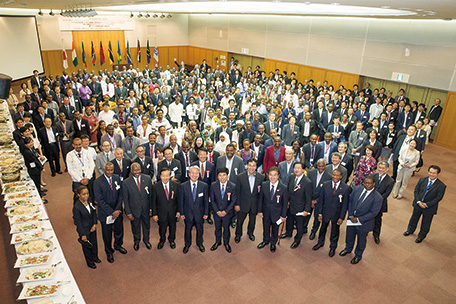
A total of 365 people participated in an “Encouragement Rally,” including representatives of the African embassies, guests from the Government of Japan, universities, and companies. (Photo: JICA)
Africa’s wealth of natural resources has supported high economic growth among its countries. Japanese industry is beginning to show a strong interest in Africa and its one billion consumers.
The Government of Japan announced public-private initiatives for fostering robust and sustainable economic development in Africa at the Fifth Tokyo International Conference on African Development (TICAD V) in June 2013. One of these initiatives is the implementation of the African Business Education Initiative for Youth (ABE Initiative).
The ABE Initiative is a five-year plan which provides 1,000 youths in Africa with opportunities to study for master’s courses in engineering, agriculture, economics/business administration, politics and other fields in Japan, and its most distinctive characteristic is to provide internship opportunities at Japanese companies.
It is expected to foster highly-educated African leaders who thoroughly understand Japanese society and Japanese corporate culture, and thereby build human networks across Japanese and African business, academia, and government. At the same time, these people will help to advance the economic activities of Japanese companies in Africa.
159 participants enrolled in the initiative in September 2014, and another 317 in September 2015. Today, they are studying at 55 universities (88 departments) across Japan. In total, 75 universities (148 departments) have shown their willingness to accept participants, and around 200 companies have shown an interest in providing internships.
For those trainees who enrolled in 2014, 65 companies across Japan accepted internships in the summer of 2015. Trainees have indicated that working at Japanese companies gave them ideas about business opportunities in Africa. They have also said that they were able to learn about Japanese corporate culture and business practices.
The companies accepting interns have also said that they benefited from hosting the interns. For example, it helped them obtain useful information for their business, establish beneficial business contacts, and globalize their workplace. It is hoped that these Japanese companies and African youth will help bridge Japan and Africa, and support Africa’s future socioeconomic development. (As of September 2015)
Kenya
Olkaria I Unit 4 and 5 Geothermal Power Project
Loan Aid (March 2010 – Ongoing)
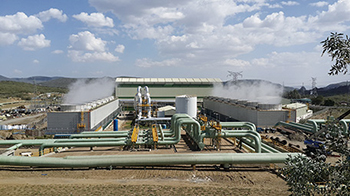
Olkaria Geothermal Power Plant. (Photo: JICA)
Kenya, in East Africa, relies on hydroelectric power for more than 70% of its annual power needs. A wide-spread drought occurred in 2007, and lasted for three consecutive years. This caused water levels to fall, which limited hydroelectric power generation capacity and caused a serious power shortage.
Kenya has experienced economic growth in recent years, and its electricity demand is expected to grow by 14.5% annually from 2010 to 2020. Kenya urgently needs to find an alternative power source to hydroelectric power, in order to provide a stable power supply.
Kenya is located in the Great Rift Valley of East Africa, which has huge geothermal potential. There are growing expectations that Kenya can develop these geothermal resources to provide a stable power supply that is unaffected by climate.
Under these circumstances, Japan initiated the Olkaria I Unit 4 and 5 Geothermal Power Project in 2010. The project will provide the first-ever ODA loan for Sub-Saharan Africa for combating climate change. Up to ¥29,516 million will be provided to develop a more environmentally-friendly power supply using geothermal power.
This ODA loan is being used to finance the expansion of Olkaria I Geothermal Power Station (installation of units 4 and 5 with total capacity of 140MW), which is located in the Olkaria Geothermal Area in Kenya’s Nakuru County (approximately 75 kilometers northwest of Kenya’s capital Nairobi).
Under the Government of Kenya’s long-term development plan Vision 2030, the Olkaria I Unit 4 and 5 Geothermal Power Project is considered a top priority, since the development of geothermal resources in Olkaria is considered to be an important foundation for supporting Kenya’s economic prosperity.
Japan’s loan aid is expected to help Kenya to generate a stable power supply. This will in turn contribute to the country’s economic development. In addition, geothermal power is a form of renewable energy, and produces less air pollution and CO2 emissions than a similarly-sized thermal power station. Therefore, the global environmental impact will also be reduced. (As of August 2015)
